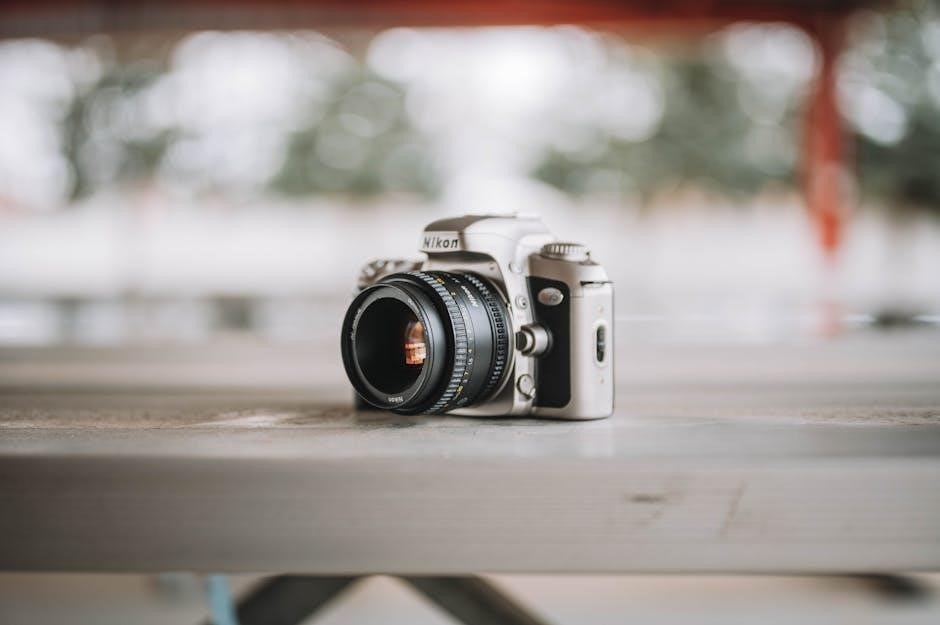nikon d7500 manual
Nikon D7500 Manual: A Comprehensive Guide
Welcome to the comprehensive guide for the Nikon D7500! This manual provides users with detailed instructions and insights into mastering their Nikon D7500 camera. It covers initial setup, advanced settings, and troubleshooting tips.
The Nikon D7500 is a powerful DSLR camera designed for photography enthusiasts and professionals alike. This camera is known for delivering exceptional image quality and versatile performance in various shooting conditions. Equipped with advanced features inherited from Nikon’s higher-end models, the D7500 offers a compelling blend of image quality, speed, and usability.
This guide will help you navigate the camera’s extensive features, from basic settings to advanced customization options. Whether you are just starting out or are an experienced photographer, this manual will provide valuable insights into maximizing the potential of your Nikon D7500. You’ll learn to adjust settings, explore creative modes, and troubleshoot common issues, ensuring you capture stunning images with confidence. Dive in to unlock the full capabilities of this remarkable camera.

Key Features and Specifications
The Nikon D7500 boasts impressive features. These include a 20.9MP sensor, EXPEED 5 processor, 4K video, and a 51-point autofocus system. These elements combine for excellent image quality and performance.
20.9MP DX-Format Sensor
The Nikon D7500 utilizes a 20.9-megapixel DX-format APS-C CMOS sensor. Crucially, it lacks an optical low-pass filter (OLPF); This design choice enhances image sharpness and detail. The DX-format sensor provides a 1.5x crop factor compared to full-frame sensors, effectively extending the reach of lenses.
This sensor excels in capturing high-resolution images with exceptional clarity and minimal noise, even in challenging lighting conditions. Combined with the camera’s advanced image processing capabilities, the 20.9MP DX-format sensor ensures stunning image quality.
The absence of the OLPF allows the sensor to resolve finer details, resulting in sharper and more detailed photographs. This is particularly beneficial for landscape, wildlife, and portrait photography where capturing intricate textures and subtle nuances is paramount. The sensor contributes significantly to the D7500’s overall image performance.
EXPEED 5 Image Processor
The Nikon D7500 is equipped with the powerful EXPEED 5 image processor. This processor is instrumental in delivering high-speed performance and exceptional image quality. It enables rapid image processing, allowing for continuous shooting at up to 8 frames per second.
The EXPEED 5 processor also contributes to the camera’s impressive low-light performance. It minimizes noise and artifacts at high ISO settings, ensuring clean and detailed images. Moreover, it supports 4K UHD video recording, providing filmmakers with a versatile tool for capturing high-resolution footage.
This advanced processor also enhances the camera’s autofocus system, enabling fast and accurate subject tracking. The EXPEED 5 is crucial for rendering vibrant colors, smooth tonal gradations, and a wide dynamic range; It efficiently handles large amounts of data, ensuring a responsive and seamless shooting experience. It’s a key component for achieving optimal image quality in various shooting scenarios.
4K UHD Video Recording
The Nikon D7500 offers impressive 4K UHD video recording capabilities, providing users with the ability to capture high-resolution videos. It supports recording at 30p, 25p, and 24p frame rates, allowing for cinematic and professional-looking footage. The camera utilizes the full sensor width during video recording, ensuring maximum image quality.
The 4K UHD video feature is complemented by the camera’s advanced image processing engine, which minimizes noise and artifacts. Users can also take advantage of features like time-lapse recording and slow-motion effects to add creative flair to their videos.
The D7500 provides external microphone and headphone jacks for enhanced audio recording and monitoring. Furthermore, it supports clean HDMI output, enabling seamless integration with external recorders and monitors. The camera’s video capabilities make it a versatile tool for both amateur and professional videographers, delivering stunning visuals and sound. It brings exceptional clarity and detail to every video project.
51-Point Autofocus System
The Nikon D7500 boasts a highly advanced 51-point autofocus (AF) system, ensuring sharp and precise focus across a wide range of shooting conditions. This sophisticated system includes 15 cross-type sensors that offer enhanced accuracy, particularly in challenging lighting situations. The AF system provides exceptional subject acquisition and tracking capabilities, making it ideal for capturing fast-moving subjects.
Users can select from various AF modes, including single-point AF, dynamic-area AF, and 3D-tracking, to match their specific shooting needs. The camera’s fine-tuning capabilities allow for precise adjustments to focus points, enhancing overall image sharpness.
With its advanced TTL phase detection, the 51-point AF system ensures reliable performance in both horizontal and vertical orientations. The system’s responsiveness and accuracy make it a valuable asset for capturing action shots, portraits, and landscapes. The autofocus system contributes to the camera’s versatility, delivering sharp and well-focused images. It’s designed to provide reliable focus in diverse shooting scenarios.

Basic Camera Setup and Operation
This section covers the essential steps for setting up and operating your Nikon D7500. Learn to navigate menus, adjust settings, and start capturing stunning photos.
Initial Settings: Date, Time, and Time Zone
Configuring the date, time, and time zone on your Nikon D7500 is crucial for accurate photo organization and time-stamping. This ensures that every image and video you capture is correctly tagged with the precise moment it was taken. Start by accessing the setup menu on your camera.
Navigate to the “Time zone and date” option. Here, you can manually set the date, time, and select your current time zone from the list provided. Accurate time settings are essential, especially when traveling across different time zones.
The D7500 also allows you to synchronize its clock with a smart device, ensuring that your camera’s time remains consistent with your other devices. Remember to adjust for daylight saving time as needed, keeping your images chronologically accurate. Proper initial settings will streamline your post-processing workflow.
Formatting the Memory Card
Formatting your memory card within the Nikon D7500 is an essential step for maintaining optimal performance and preventing potential data corruption. Before you begin, ensure that you have backed up any important photos or videos stored on the card, as formatting will erase all data.
To format the card, access the camera’s setup menu and locate the “Format memory card” option. The D7500 will display a warning message, reminding you that all data will be deleted. Confirm your decision to proceed with the formatting process.
It’s crucial not to power off the camera or remove the memory card during formatting. This can cause irreparable damage to the card. Regularly formatting your card helps to clear any residual files, optimize write speeds, and ensure reliable storage for your new images and videos, contributing to a smoother shooting experience.
Custom Settings and User Modes
The Nikon D7500 provides custom settings and user modes (U1, U2) to tailor the camera to your specific shooting preferences. These modes enable quick access to pre-configured settings.
Saving and Recalling User Settings (U1, U2 Modes)
The Nikon D7500 offers U1 and U2 modes for saving frequently used camera settings. This feature allows photographers to quickly switch between different shooting scenarios without manually adjusting individual settings each time. To save settings to a U1 or U2 mode, navigate to the setup menu and select “Save User Settings.” Choose either U1 or U2 to store the current camera configuration, including exposure mode, aperture, shutter speed, ISO, white balance, and autofocus settings.
Recalling these saved settings is simple: rotate the mode dial to either U1 or U2. The camera will instantly apply the stored configurations, enabling a seamless transition between shooting styles; This is particularly useful for situations where you frequently switch between landscape, portrait, or action photography. Furthermore, these modes streamline workflow and reduce the chance of missing crucial moments due to manual adjustments. By effectively utilizing the U1 and U2 modes, photographers can enhance their efficiency and capture consistent, high-quality images in diverse shooting conditions.
Customizing Autofocus Settings (a3, a8)
The Nikon D7500 provides extensive customization options for its autofocus system, allowing users to fine-tune performance based on specific shooting needs. Settings “a3” and “a8” within the custom settings menu offer control over crucial autofocus behaviors. Setting “a3,” often related to focus tracking with lock-on, determines how quickly the camera will reacquire focus on a subject if temporarily obstructed or moving erratically. Adjusting this setting allows photographers to prioritize either a stable focus lock or a quick response to changing subjects.
Setting “a8,” typically associated with focus point options, controls how the camera selects and displays focus points. Users can customize whether all focus points are displayed, or only the active ones, and how the camera transitions between focus points. These customizations are instrumental in capturing sharp images in dynamic scenarios. By understanding and tailoring these “a3” and “a8” autofocus settings, photographers can maximize the D7500’s autofocus capabilities and achieve optimal results in various photographic situations, including sports, wildlife, and portraiture;

Advanced Features and Functions
Explore the advanced capabilities of the Nikon D7500, including metering modes and diverse shooting options. Unlock creative potential with features designed for experienced photographers seeking greater control.
Understanding Metering Modes
The Nikon D7500 offers several metering modes to control how the camera measures light for optimal exposure. Understanding these modes is crucial for achieving properly exposed images in various shooting conditions. The primary metering modes include Matrix metering, which evaluates the entire scene for balanced exposure. Center-weighted metering focuses on the center of the frame, giving it more importance in the exposure calculation.
Spot metering measures light only at the selected focus point, ideal for high-contrast situations. Highlight-weighted metering prioritizes highlights, preventing overexposure in bright areas. Selecting the appropriate metering mode ensures accurate exposure and creative control over your photographs, allowing for better image quality. Experiment with each setting.
Exploring Shooting Modes
The Nikon D7500 provides a variety of shooting modes designed to cater to different photographic scenarios and user skill levels. Auto mode is fully automatic, letting the camera handle all settings. Scene modes optimize settings for specific situations like portrait, landscape, or sports. Program mode (P) allows the camera to set aperture and shutter speed automatically, while still letting the user adjust other settings.
Aperture-priority mode (A) lets you select the aperture, while the camera sets the shutter speed. Shutter-priority mode (S) lets you choose the shutter speed, while the camera selects the aperture. Manual mode (M) gives complete control over both aperture and shutter speed, essential for advanced users.

Troubleshooting and Maintenance
This section addresses common Nikon D7500 issues and their solutions. It also covers essential maintenance tips to keep your camera in optimal condition, ensuring long-lasting performance and reliability.
Common Issues and Solutions
Encountering issues with your Nikon D7500 is not uncommon, but most problems have straightforward solutions. This section outlines frequently encountered problems, such as autofocus malfunctions, exposure inaccuracies, and error messages. For autofocus issues, ensure the lens is properly attached and clean.
Exposure problems can often be resolved by checking metering modes and exposure compensation settings. Error messages usually indicate a specific problem, like a full memory card or a lens compatibility issue. Always refer to the camera’s display for specific error codes.
Additionally, problems related to image quality, such as noise or blur, can be addressed by adjusting ISO settings and shutter speed. Regular maintenance, like cleaning the sensor and lens, can prevent many common issues, ensuring your camera continues to perform optimally. By understanding these common issues and their solutions, users can quickly resolve problems and continue shooting without significant interruptions.
